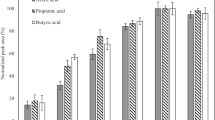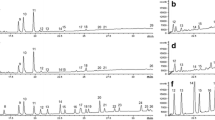Abstract
Non-esterified fatty acids (NEFA) are the main components of triglycerides and are related to an adequate body energy balance. NEFA concentration is a direct indicator of the lipolysis rate of the body, and their deficiency in serum and blood plasma can lead to several physiological disorders, such as diabetes and insulin resistance. Therefore, determining and monitoring NEFA concentration is extremely valuable for diagnosing and controlling such diseases, and there are numerous analytical techniques for this purpose, each one with its peculiarities, benefits, and drawbacks. This chapter aims to bring the most common techniques for determining NEFAs in serum and plasma, detailing all the steps necessary for developing an analytical method, from sample preparation to method validation.
Access this chapter
Tax calculation will be finalised at checkout
Purchases are for personal use only
Similar content being viewed by others
References
Karpe F, Dickmann JR, Frayn KN (2011) Fatty acids, obesity, and insulin resistance: time for a reevaluation. Diabetes 60(10):2441–2449
eClinpath (2020) [cited November 24, 2020]. Available from: eClinpath: https://eclinpath.com/chemistry/energy-metabolism/non-esterified-fatty-acids/
Gonçalves-de-Albuquerque CF et al (2019) Serum albumin saturation test based on non-esterified fatty acids imbalance for clinical employment. Clin Chim Acta 495:422–428
Roden M (2004) How free fatty acids inhibit glucose utilization in human skeletal muscle. News Physiol Sci 19:92–96
Kang J et al (2014) Electrochemical detection of non-esterified fatty acid by layer-by-layer assembled enzyme electrodes. Sens Actuators B Chem 190:535–541
Kopf T, Schmitz G (2013) Analysis of non-esterified fatty acids in human samples by solid-phase-extraction and gas chromatography/mass spectrometry. J Chromatogr B Analyt Technol Biomed Life Sci 938:22–26
Miksa IR, Buckley CL, Poppenga RH (2004) Detection of nonesterified (free) fatty acids in bovine serum: comparative evaluation of two methods. J Vet Diagn Invest 16(2):139–144
Christmass MA et al (1998) A semiautomated enzymatic method for determination of nonesterified fatty acid concentration in milk and plasma. Lipids 33(10):1043–1049
Carlson LA (1958) A colorimetric method of determining unesterified fatty acids in plasma. Scand J Clin Lab Invest 10(4):407–414
Chilliard Y, Bauchart D, Barnouin J (1984) Determination of plasma non-esterified fatty acids in herbivores and man: a comparison of values obtained by manual or automatic chromatographic, titrimetric, colorimetric and enzymatic methods. Reprod Nutr Dev 24(4):469–482
Dole VP, Meinertz H (1960) Microdetermination of long-chain fatty acids in plasma and tissues. J Biol Chem 235:2595–2599
Trout DL, Estes EH Jr, Friedberg SJ (1960) Titration of free fatty acids of plasma: a study of current methods and a new modification. J Lipid Res 1:199–202
Rogiers V (1977) The application of an improved gas-liquid chromatographic method for the determination of the long chain non-esterified fatty acid pattern of blood plasma in children. Clin Chim Acta 78(2):227–233
Chu X et al (2009) Determination of 13 free fatty acids in pheretima using ultra-performance LC-ESI-MS. Chromatographia 69(7):645–652
Costa CG et al (1998) Simultaneous analysis of plasma free fatty acids and their 3-hydroxy analogs in fatty acid beta-oxidation disorders. Clin Chem 44(3):463–471
Trufelli H et al (2011) Profiling of non-esterified fatty acids in human plasma using liquid chromatography-electron ionization mass spectrometry. Anal Bioanal Chem 400(9):2933–2941
Menéndez LG et al (2001) Effect of storage of plasma and serum on enzymatic determination of non-esterified fatty acids. Ann Clin Biochem 38(Pt 3):252–255
Shimizu S et al (1979) Acyl-CoA oxidase from Candida tropicalis. Biochem Biophys Res Commun 91(1):108–113
Sode K et al (1989) Sensor for free fatty acids based on acyl coenzyme-a synthetase and acyl coenzyme-a oxidase. Anal Chim Acta 220:251–255
Veerapandian M, Hunter R, Neethirajan S (2016) Lipoxygenase-modified Ru-bpy/graphene oxide: electrochemical biosensor for on-farm monitoring of non-esterified fatty acid. Biosens Bioelectron 78:253–258
Antonis A (1965) Semiautomated method for the colorimetric determination of plasma free fatty acids. J Lipid Res 6:307–312
Pavićević ID et al (2016) Quantification of total content of non-esterified fatty acids bound to human serum albumin. J Pharm Biomed Anal 129:43–49
Ecker J et al (2012) A rapid GC-MS method for quantification of positional and geometric isomers of fatty acid methyl esters. J Chromatogr B Analyt Technol Biomed Life Sci 897:98–104
Baird JD, Black MW, Faulkner DE (1967) Semi-automated method for the determination of free fatty acids in plasma. J Clin Pathol 20(6):905–909
Sellin J et al (2020) Free fatty acid determination as a tool for modeling metabolic diseases in Drosophila. J Insect Physiol 126:104090
Tinnikov AA, Boonstra R (1999) Colorimetric micro-determination of free fatty acids in plasma using microplate readers. Clin Chim Acta 281(1–2):159–162
Bicalho B et al (2008) Creating a fatty acid methyl ester database for lipid profiling in a single drop of human blood using high resolution capillary gas chromatography and mass spectrometry. J Chromatogr A 1211(1–2):120–128
Marangoni F, Colombo C, Galli C (2004) A method for the direct evaluation of the fatty acid status in a drop of blood from a fingertip in humans: applicability to nutritional and epidemiological studies. Anal Biochem 326(2):267–272
Pulfer M, Murphy RC (2003) Electrospray mass spectrometry of phospholipids. Mass Spectrom Rev 22(5):332–364
Sommer U et al (2006) LC-MS-based method for the qualitative and quantitative analysis of complex lipid mixtures. J Lipid Res 47(4):804–814
Balogh O et al (2018) Effect of maternal metabolism on fetal supply: glucose, non-esterified fatty acids and beta-hydroxybutyrate concentrations in canine maternal serum and fetal fluids at term pregnancy. Anim Reprod Sci 193:209–216
Brenna JT et al (2018) Best practices for the design, laboratory analysis, and reporting of trials involving fatty acids. Am J Clin Nutr 108(2):211–227
National Health Surveillance Agency (2003) Guide for validation of analytical and bioanalytical methods analytical methods. Resolution – RE No. 899
Mocking RJ et al (2012) Statistical methodological issues in handling of fatty acid data: percentage or concentration, imputation and indices. Lipids 47(5):541–547
Acknowledgments
The authors would like to thank the São Paulo Research Foundation (FAPESP—Ph.D. grant for M.R.V.B., 2019/18748-8) and Coordination for the Improvement of Higher Education Personnel (CAPES Foundation—Brazil) Financing Code 001.
Author information
Authors and Affiliations
Corresponding author
Editor information
Editors and Affiliations
Rights and permissions
Copyright information
© 2022 The Author(s), under exclusive license to Springer Science+Business Media, LLC, part of Springer Nature
About this chapter
Cite this chapter
Bertolo, M.R.V., Bogusz Junior, S. (2022). Quantification of Non-esterified Fatty Acids in Serum and Plasma. In: Betim Cazarin, C.B. (eds) Basic Protocols in Foods and Nutrition. Methods and Protocols in Food Science . Humana, New York, NY. https://doi.org/10.1007/978-1-0716-2345-9_6
Download citation
DOI: https://doi.org/10.1007/978-1-0716-2345-9_6
Published:
Publisher Name: Humana, New York, NY
Print ISBN: 978-1-0716-2344-2
Online ISBN: 978-1-0716-2345-9
eBook Packages: Springer Protocols




